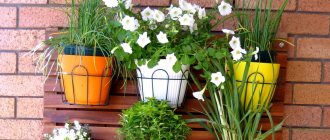Where to start: design principles
Turning a balcony into a romantic, blooming place is not difficult if you start not with choosing plants, but with clarifying the following points:
- What is the area and proportions of the balcony (loggia).
- Which side of the world does it face, how long does it remain in the shade, is there glazing.
- Number of storeys. The higher the balcony is located, the more extreme the conditions. Not all plants like strong winds and drafts.
Relaxation corner Source amazonaws.com
Design of small and large spaces
If you don't know how to decorate a balcony with potted flowers, start by assessing the available space. On a small balcony you will have to save space so that there is enough space not only for flowers, but also for you. A practical technique is horizontal landscaping along the balcony railings, which allows you to create visual volume. It can be implemented in the following ways:
- Flower boxes are mounted on railings close to each other or placed along the fence, resulting in a continuous line.
- The containers are not hung on the railings, but are fixed on the fence in a cascade, at several levels. If the fence is lattice, this can be done both inside and outside.
On a small balcony Source ogrodniktomek.pl
- On a miniature balcony, you can limit yourself to a container or a large pot of an unusual shape, complemented by assorted flowers.
- Vertical gardening will help save precious square meters.
On a large balcony or loggia there is room for your creative imagination to run wild. There is room here not only for garden flowers and herbs, but also for larger plants. True, if there is no glazing, then, starting from the 6-7th floor, it is better to refuse large views.
On the open loggia Source dobrzemieszkaj.pl
But there is enough space for shelving, various hanging structures and voluminous containers and pots in which perennials will be comfortable. Vertical gardening will also look beautiful, for which trellises are installed in the right places and guides are extended for the climbing hedge.
On a medium-sized balcony, the same design techniques are available, but adjusted for the available area. Light pots are hung on the railings, more compact stands are chosen, and on the floor it is most convenient to place flowers along the walls and parapet in one row.
On the middle balcony Source valent.pl
Choosing a location for a mini-garden
A balcony located on the sunny side is perfect for all plants. Some will need a little shading, but this can be done by those flowers that need an abundance of sun . For everyone, it is necessary to optimize the watering regime - you need to water more often and more abundantly. As a result, you will get a beautiful landscape under the windows, shading and fresh air, and the flowers will have a lot of oxygen, sun and active growth.
How to decorate a balcony with flowers on the north side or located in a draft? In this case, domestic perennial plants are placed closer to the wall of the house, flowering annuals are planted in pots and placed on the median line, climbing flowers will feel good on the parapet of the fence.
Pay attention to the color scheme of the plants so that the flower garden does not blend in with the color of the walls and is pleasing to the eye . Against the background of a red brick wall, white, green, and yellow plants will look beautiful, but flowers with red leaves or flowers will become invisible. The background will improve the position; a fashionable trend is a painted brick wall.
If changing color is not your plan, use plants with shading colors. Wall-mounted planters are a good solution. They can be hung, fixed directly to the wall, and by planting climbing plants in them, you will get a miniature vertical garden in front of the windows. It will look like the image below.
Annual plants:
Household perennial plants that live on the windowsills of our houses are loved, but they cannot always form a complete composition for a balcony garden. Sometimes it is even harmful to take them outside the apartment; a change in the microclimate can adversely affect its vital functions. The best option for organizing a green area on a balcony or loggia are unpretentious annual plants. When choosing plants for planting, consider their need for sunlight. The loggia often receives less light, so for this room it is better to choose plants with a low sun requirement. You can reliably find out what a balcony with mature plants will look like by looking at the illustration on a bag of seeds.
The best option for organizing a green area on a balcony or loggia are unpretentious annual plants!
For shaded spaces:
- Begonia: has all the decorative qualities and is easy to care for. A wide range of colors and a variety of varieties will make the open or closed space of the balcony an Eden. Climbing plants will help add luxury to begonia compositions .
Related article: Beautiful false window with lighting for an apartment
- Sweet peas: used for both hanging and border decoration. Annual pea plants come in many shades of color, are decorative and require little care.
- Anemones: unpretentious plants with amazing diversity. You will be surprised by the splendor of flowering and ease of care.
For solar:
- Petunia: the ideal inhabitant in a limited space. The inflorescences are varied in shape, color and type. Climbing varieties are beautiful in hanging flowerpots and complex compositions; surface varieties cover the pot with a beautiful head of flowers. You can decorate your balcony with your own hands only with the help of different varieties of petunias. By planting several varieties in one pot, you will get an explosion of color, brightness and emotion.
- Geranium: a long-time resident of our latitudes. Excellent propagation by cuttings. Lives outside in the summer and winters in pots on the windowsill. It has a pronounced decorative effect of leaves, flowers, shapes. Blooms almost all year round.
- Pansies: The friendly appearance of these flowers will delight you all season long with their variety of colors and shapes.
- Nasturtium: takes root in any pot and blooms gratefully until the cold weather. There are regular and climbing varieties. It will enhance any unsightly corner or wall.
Illumination
Be sure to find out which side your balcony faces. The fact is that plants react to sunlight in different ways. One needs diffused light, another needs bright sun, and the third will wither if it is not reliably protected from even small doses of ultraviolet radiation. Knowing how certain flowers relate to sunbathing, you can choose the best plants for your conditions.
Scandinavian design Source wp.com
South orientation
In summer, daylight hours on the south side extend to 12 hours. For such conditions, they choose not just heat-loving, but unpretentious and drought-resistant flowers. Kalanchoe, sedum, hibiscus, azalea are ideal for colonization. They can be supplemented with bidens, nemesia, and nasturtium. A variety of cacti, succulents, purslane, heather and gerbera are also good choices.
Pink periwinkle and verbena, which has a delicate aroma, will successfully complement the collection. If you are planning to organize a hedge, you cannot do without picturesque climbing plants: fiery red beans, morning glory, sweet peas.
On the sunny side Source dobrzemieszkaj.pl
All of these plants thrive in direct sunlight, but in order for their development to be complete and their flowering to be abundant, regular watering will be required. Plants need to be watered in the morning or evening. It's also a good idea to stock up on screens or blinds to give your flowers a break on the hottest days.
On the south side you can plant wildflowers (chamomile, calendula), herbs (rosemary, sage, thyme). But if herbs grow in urban polluted air, it is better not to eat them.
Sedum Source pinimg.com
North orientation
Shade-tolerant flowers should be grown here: fern, periwinkle, mimulus, fuchsia, marigold. You can grow ivy and hosta in containers. Some sun-loving plants (for example, nasturtium) can also adapt to chronic lack of sun, but they will not bloom as well.
In the courtyard-well Source dobrzemieszkaj.pl
Orientation east and west
Here, the sun's rays delight the plants during partial daylight hours, mainly in the morning or evening hours, which suits most plants. Impatiens, violets, marigolds, begonias, petunias, pansies, and clematis will thrive in moderate light.
A good choice is geranium (pelargonium), known for its variety of shapes and colors.
If the area allows, the balcony composition can be supplemented with a tall plant, dracaena or palm tree. Species that do not like drafts and temperature changes, for example, Saintpaulia and gardenia, are planted on the glazed balcony.
Spring garden Source pinimg.com
See also: Catalog of companies that specialize in landscape work of any complexity
Selecting colors for special conditions
Open balconies are suitable for decorating a summer composition. If the balcony is glazed and the winter temperature does not drop below +15°C, you can think about perennial plants for organizing a winter garden.
But, if you live on the 7th-8th floor and above, and there is no glazing, you should opt for colors that are resistant to wind and rain:
- Geranium, ivy, flax, begonia, snapdragon are not afraid of the wind.
- Calendula, hyacinth, and marigolds are unpretentious and resistant to rain.
Marigolds Source balkonyi.ru
Plants with beautiful leaves
Bright, lushly flowering plants are not the only way to create an attractive flower garden on the balcony; ideas for truly original compositions are rarely complete without plants with leaves of unusual shapes and colors. The following species are suitable for cultivation on the balcony:
- With exit to the north. Advantage can be safely given to ferns; The usual nephrolepis or any of the many adiantums (for example, Venus hair) will do. In conditions of lack of light, tradescantia, persistent sansevieria and ivy will take root well (just choose green, monochromatic forms).
Nephrolepis Source dom-elite.com
- On the south side. Various varieties of perilla will take root here (both green and burgundy, with pink veins), and an equally diverse range of coleus. An elegant dichondra (emerald and silver) and lush chlorophytum are suitable. An interesting color effect can be achieved by using Schmidt or Steller wormwood.
- In the east and west. Here you can plant the same variegated forms as on the south side, as well as dichondra and chlorophytum. A narrow balcony can be decorated with a long container with oxalis (oxalis); In its different varieties, the leaves are colored green, purple, and burgundy.
Coleus Source premierseedsdirect.com
How to decorate a balcony with flowers - tips for arranging an apartment flower garden
A flower garden on a balcony, unlike a dacha, is convenient because you don’t need to go anywhere. You open the door - and here it is your personal oasis.
Do you love floriculture, but you don’t have your own home or cottage to organize a flower garden? There is a way out - your own balcony! Usually this corner of the apartment is turned into a warehouse for various rubbish, a kind of makeshift storage room. But it’s not difficult to turn it into a cozy paradise – a blooming garden among the concrete jungle. Among the pots of herbs, it’s nice to sit and drink tea, read a book or just relax. And it doesn’t matter whether the balcony is glazed or not. For both options, you can choose a landscaping method.
- Selecting containers for flowers
- The best plants for the balcony
- Subtleties of care
- Blooming balcony from spring to autumn
- Making a beautiful flower arrangement
Selecting containers for flowers
If you decide to start growing flowers on the balcony, then, first of all, you need to buy containers suitable for this. Ordinary flower pots are good for glazed balconies with a window sill, where they are placed. A couple of large flowerpots can be placed directly on the floor or on low stands. For open balconies, hanging flowerpots are the best choice. They come in different shapes - traditional pots or oblong boxes.
They can be hung both from the outside and from the inside of the balcony railings. When choosing hanging pots, make sure that they have a tray to collect excess water. If you hang containers without a fixed tray, then with each watering you will inevitably flood either your own balcony or your neighbors’ drying laundry. General advice on choosing pots should also be taken into account.
The best plants for the balcony
For growing on the balcony, it is better not to use plants for indoor floriculture; most annual and perennial garden flowers are suitable here. The convenience of annuals is that in the fall they are simply cut off and thrown away, while perennials need a separate place for wintering. Choose plants with compact bushes and a not very developed root system. The hanging or climbing types look very beautiful; with their help you can turn the balcony into a real gazebo.
The best balcony annuals with beautiful flowers:
- low-growing marigolds;
- annual dahlias;
- petunia;
- nasturtium;
- gatsaniya;
- ageratum.
Ageratum mexicanis
Climbing and climbing plants. Many not only have beautiful flowers, but also attractive foliage:
- lobelia;
- verbena;
- ampelous petunia;
- morning glory;
- kobeya;
- Turkish beans.
Beans (Turkish beans)
To make relaxing on a green balcony even more enjoyable, you should plant a couple of flower bushes with a pleasant smell. The flowers of such plants are sometimes inconspicuous, but the divine smell compensates for this omission of nature. Fragrant plants:
- sweet pea;
- matthiol;
- allisum.
If you are not afraid of difficulties with winter storage, you can get perennial plants. If you are the owner of a glazed balcony, this option is for you. In summer, perennials will bloom in pots hung outside, and in winter they will sleep peacefully inside if the balcony does not freeze. Some of them can be used as indoor flowers. Perennials for the balcony:
- fuchsia;
- tuberous begonia;
- pelargonium;
- aquilegia;
- perennial chamomile.
Subtleties of care
In order for your garden to be lush and pleasing to the eye, you need to tirelessly look after it. Watering is especially important, because the soil in small pots dries out very quickly. In particularly hot weather, flowers may need spraying. It is carried out in the evening hours so that the plants do not get burned.
Flowers need suitable soil and periodic feeding. It is better to go to the store for the soil mixture, so you are guaranteed to get a good result. If you feel confident in your abilities, you can make the soil yourself. To do this, you need to mix ordinary garden and leaf soil in equal quantities, then add a little sand and humus.
For additional nutrition with useful substances, sticks or granules of slowly soluble fertilizer can be placed in the pots. If during the summer you notice that the flowers are not as lush, apply additional fertilizing with liquid fertilizer.
Blooming balcony from spring to autumn
Do you want to enjoy beauty from the first warm days until late autumn? Nothing could be easier! Just plant the plants in several stages. It is especially convenient to create new compositions using ready-made purchased seedlings. The first inhabitants of the flowerpots will be spring primroses, daisies, and pansies. After their flowering comes the turn of petunia, gatsania, marigolds, and ageratum.
These annuals bloom for a very long time if they are fed and faded flowers are trimmed in time. To extend flowering until frost, sow a new batch of annuals in mid-summer. When the first wave begins to bloom, it will be the turn of the plants to be re-sowed.
Making a beautiful flower arrangement
If you have been interested in growing flowers on your balcony for several years, arranging flowers beautifully in flowerpots will not be difficult. And for beginners in this matter there are small tips. You can choose plants with flowers of the same color or, conversely, play with contrast. They combine low-growing and climbing species, beautifully flowering and decorative foliage. Here are some options for win-win flower arrangements:
- Orange summer . Low varieties of marigolds and gazania are planted in the center of the pots. Ampelous nasturtium is placed along the edges. The combination of rich orange flowers and emerald greenery looks very sunny.
- Country style balcony . Turkish beans are planted as climbing plants. The main space of the pots is filled with a variegated mixture of marigolds, bush nasturtium, salvia and annual dahlias.
- Flower waterfalls . In this composition the main emphasis is on hanging plants. Multi-colored hats hanging from the balcony railings are sure to attract everyone's attention. The ideal plant for these purposes is ampelous petunia. A balcony decorated with different varieties of petunias will always look chic.
Growing flowers on the balcony is a wonderful hobby. Caring for green pets distracts you from the bustle of the city. And a balcony buried in flowers will delight not only you, but also all passers-by admiring this beauty.
If you never care for plants, create a miniature rock garden or try your hand at floristry.
Plant color selection
Owners who strive to achieve a harmonious combination of colors on the balcony in their design, as a rule, are guided by their color palette. It is also important that they match in color not only with each other, but also with the design of the balcony. The easiest way to achieve harmony is with the following tips:
- The color of containers and flowerpots can be any, but plain containers in white, terracotta and green always look good.
- Plants should not blend into the decor of the balcony, but too much contrast is not always appropriate.
Symmetrical composition Source joey.on.ge
- The easiest way to choose plants is if the balcony is decorated in a white or natural palette - color combinations can be any. The same goes for the brick background.
- If the load-bearing wall has a more saturated shade, flowers can be selected either to match or in contrast to it; The main thing is that the containers are in harmony with the wall in color.
- A win-win combination is obtained by combining flowers of the same type, but of different shades. Plants of the same species, but of different varieties, will also look good.
One look, two colors Source depositphotos.com
Balcony landscaping: preparing the room and creating comfort
In order for the plants of an open balcony, terrace or loggias to look harmonious, you need to think through the arrangement plan and the overall design of the green corner. Before choosing and purchasing plants, the room needs to be prepared. Here's what you can do to make the room more comfortable:
- Free up as much space as possible. To do this, rid the balcony of old unnecessary things, bulky cabinets and tables.
- Hang light, beautiful curtains or order blinds for the window. This will create coziness and help protect the oasis from the sun's rays.
- If space allows, place a wicker chair and a small table in the center or corner.
- Buy interesting plant pots and a few standard flower boxes and paint them in interesting bright shades.
The principle of landscaping a balcony, designing cozy loggias
DIY garden on the balcony - flowers on the balcony.
To ensure that the plants do not look chaotic, you need to think in advance which flowers will suit your balcony and how to arrange them without cluttering up the usable space. For a small balcony, horizontal landscaping is often used. You can choose one of any options:
- Place flower pots in one line along the entire length of the railing close to each other.
- Pots or boxes do not need to be hung, but placed at the same level on a low stand or on the floor. This will give an interesting effect.
- Instead of small containers, take one or two large boxes and create a whole flower arrangement in them from different types of plants. Place the boxes in a visible place. They can be placed or hung at different levels parallel to each other or in a “step”.
For large balconies, it is preferable to choose horizontal landscaping. In this case, when decorating a balcony with flowers, the scope for creativity is much wider. Here, too, there are various options that you need to think through in advance and settle on one thing:
- select one free wall and install supports for climbing flowers on it: honeysuckle, actinidia, Schisandra chinensis, decorative beans; sweet peas, nasturtium... You can install a lattice. Then, in addition to the flowers creeping up, it will be possible to hang several flowerpots with hanging shoots;
- hang several large hanging baskets in different places on the walls of the balcony;
- install a vertical rack. It will be possible to place both indoor flowers and annual outdoor plants in boxes or small pots. Plan vertical gardening on the balcony in the same way as the interior of the room. Suitable plants: ornamental grapes, lemongrass (Schizandra), moonflower, ampelous loach.
Beautiful balcony flowers for landscaping the balcony.
Balcony landscaping: what flowers to plant on the balcony
In order for the flowers on the balcony to grow well and have an aesthetic appearance, you need to choose the right flowers to bloom for the balcony. What should you pay attention to first? Here are a few rules that will allow you to create a harmonious composition.
First of all, when decorating a loggia with flowers, you need to pay attention to the growth conditions of a particular flower. For northern balconies, choose shade-tolerant plants that will not suffer from a lack of sunlight. If the balcony faces south, on the contrary, give preference to those colors that are not afraid of bright rays.
What flowers should I plant on the balcony?
In order for the composition to look aesthetically pleasing, you need to maintain the overall style. Plants are selected based on the color of the leaves (matching or contrasting), the shape of the bush, and the shade of the flowers. Excessive diversity most often turns out to be inappropriate in the limited space of the balcony. It is important to correctly position plants of different heights and sizes. In a symmetrical ensemble, the tallest flower can be placed in the center. Flowers to grow on the balcony.
| № | Plants for the balcony | Genus of balcony plants | Height, in (cm) |
| 1. | Waller's balsam. | Variety of flower colors and ability to grow in shade and sun | 15 — 60 |
| 2. | Geranium. | Geranium family, container plants. | 30 — 50 |
| 3. | Lobelia. | Family Campanulaceae, herbaceous plants. | 10 — 25 |
| 4. | Verbena. | Family Verbenaceae, 124 species. | 25 — 45 |
| 5. | Petunia. | Genus of herbaceous plants, Solanaceae family. | 10 —100 |
| 6. | Ampelous alyssum. | Family Brassicas (Cruciferae. | 15 — 40 |
| 7. | Brachycoma iberisolifolia. | Originally from Western Australia. | 20 — 40 |
If you want to make a non-standard composition, large crops are moved to the background towards the edge, and low-growing flowers are placed in the foreground. With vertical gardening, the proximity of ampelous, climbing and erect flowers is quite acceptable. The color of pots and cache-pots should be in harmony with the general appearance of the plants.
It is important to choose the correct container size so that the flower looks proportional.
For bright flowering plants, it is worth choosing more austere monochromatic pots. Conversely, green plants with discreet, medium-sized leaves will look advantageous against the background of an unusually shaped pot or a bright box with an interesting pattern. Plants for a cold balcony.
| № | Plant genus | Height (cm) | |
| 1. | Camellia (lat. Camellia) | Camellia, Tea family | 1-200 |
| 2. | Hyacinth (Hyacinthus). | Family Asparagus or Liliaceae. | 25 – 30 |
| 2. | Heather (lat. Calluna). | Heather. Flowering plants, family Ericaceae. | 30– 60 |
| 4. | Cyclamen. | Plants of the Myrsinaceae subfamily of the Primrose family (55 species). | 15 – 30 |
| 5. | Hebe (lat. Hebe breviracemosa) | Hebe, low-growing shrub, plantain family. | 40-50 |
| 6. | Citrus fruits (lat. Citrinae) | Citrus fruits, Rutaceae family | from 150 |
| 7. | Laurel (lat. Laurus) | Subtropical trees or shrubs | from 100 |
Citrus fruit care
Citrus fruits are pleasing in the fall and spring, and the plant remains green all year round. For irrigation, use chlorine-free water; if the water is hard, it is advisable to boil it. You can add a few drops of lemon juice. The water must be at room temperature. Moderate watering, do not overdo it, the citrus plant is demanding of light.
Containers and accessories
Once the flowers have been chosen, you should think about their optimal arrangement. Specialty stores and garden centers offer a variety of containers for flowers. Containers and accessories are chosen based on your preferences and the characteristics of the balcony.
If its fencing is a lattice or balustrade, you can choose beautiful pots, flowerpots or baskets and safely place them on the floor. All types of flowers are planted in floor containers; hanging varieties look especially beautiful.
Modern design with containers Source miro.medium.com
Popular models of floor boxes and pots are made of ceramic and plastic; some plastic containers are equipped with wheels for ease of movement.
Elongated ceramic containers are suitable not only for planting flowers, but also for creating a mini-lawn. Moisture does not stagnate in a porous ceramic container, which has a beneficial effect on indoor and garden crops. Sometimes the surface of the ceramic imitates natural stone, so the container has an organic look in any composition.
Fastening on the inside Source roomble.com
Growing conditions and care for balcony flowers
Flowers growing in a pot on a balcony or loggia require more careful care than their counterparts in the open ground. The main reason for this feature: the plants have a limited feeding area, cramped by the pot. Consequently, without the sensitive attention of the grower and his caring hand, potted plants will not be able to grow and bloom normally.
Here's what to do when growing flowers on your balcony:
- Feed your plants regularly. In the first 30-40 days after transplanting seedlings to a permanent place, it is optimal to feed once every 2 weeks, then you need to increase the frequency and feed approximately once every 7-10 days. Complex fertilizers specifically for balcony crops or indoor flowers are suitable for these purposes.
- Provide different crops with suitable conditions. To write that different crops need different growing conditions is a merciless truism. However, this truth is true in all cases. Be sure to take into account the preferences of different colors in terms of lighting, watering, ventilation, and temperature conditions. Depending on which balcony you want to plant (south, north, west, east), choose suitable plants.
- Don't forget about proper watering. You should not allow the earthen ball to dry out completely (except, perhaps, for the most drought-resistant species), and you should not allow excessive waterlogging, which will have a bad effect on the health of the plant. For irrigation, it is best to use only settled, clean water (preferably filtered). It is difficult to say how often to water the pots, because under different weather and temperature conditions the frequency of watering can vary from once a day to once a week.
It's no secret that happiness and positive emotions can be found in the little things. For example, go out in the evening with a cup of tea on a balcony decorated with flowers and enjoy the delicate beauty and aromas of colorful plants. You can surround yourself with the splendor and harmony of the Garden of Eden at home, isn’t it?
Video description
About unpretentious annuals in the following video:
When deciding how to decorate a balcony with flowers and create an interesting composition, do not forget about the following accessories that help save space:
- Hanging baskets, wall planters. In order not to have problems with such items, it is enough to securely fasten them and hang them at eye level for easy watering.
- Canvas with pockets. An original wall flower holder for placing plants on the balcony. You can find it in the store or make it yourself, for which you will need a durable, air-permeable fabric (tarpaulin or canvas). The pockets must be able to support the weight of small pots.
Containers for every taste Source elle.pl
- Trellis. You can’t do without it if you want to plant climbing plants. Inexpensive trellises are made of plastic and wood, but you can also order an unusual forged version. The trellis doesn't save space since the containers remain on the floor, but a wall of greenery with flowers makes an impressive decor.
- Shelves for containers with flowers. You can also buy or make it yourself. Most likely, they will be made of wood, but sometimes you come across interesting options, for example, made of bamboo.
Stylish shelves made from drawers Source backend.elle.de
Stands, hanging holders, flower tables
To arrange all the flowers and compositions on the balcony, additional funds are needed.
Pay attention to the hanging flower holders. They are comfortable, decorate the walls, and show off all the beauty of hanging plants. To understand what they look like, remember a standard birch tree with two stands for flower pots - this is the most prosaic, but still relevant, option for hanging flowers on the wall. Multi-level shelves or shelves with one plane are suitable. Boxes made of wood and plastic are popular. It all depends on the amount of space on the wall or floor and the flowers that will live there.
Hanging flower holders are the most prosaic, but still relevant, option for hanging flowers on the wall!
Some pots can stand on the floor - this is important for tall plants against the wall . If the balcony is open, low-growing plants can be placed closer to the floor with a lattice fence; for compactness, they can be placed in boxes. If the outer side of the fence is sewn up, then the plants require placement in other available ways.
Related article: Do it yourself: original ways to paint walls (+48 photos)
Numerous options for flower stands provide a lot of possibilities for balcony design. From miniature single pot stands to multi-tiered tables to suit your needs. Tables and shelves can be replaced with painted boxes of different heights. They are presented to choose from in any construction or specialized florist store or from photos from catalogs of online portals. Lightweight, inconspicuous metal structures are suitable for flowers that grow throughout the season; literally a month after planting the begonia, the stand will not be visible, but the beauty of the flower can be admired without interference. If the balcony is small, use more external window sill and fencing.
If the balcony is small, use more external window sill and fencing.
You can hang flowers in separate pots or decorate the outer perimeter of the fence with them. Self-made pendants for compositions will be much more attractive - exclusivity is always in trend. Flowers in boxes made of wood or plywood will complement the composition. Before you start landscaping your property, take a closer look at photos and videos - materials on the topic so that your mini-garden becomes beautiful.
Video gallery
Photo gallery
What and where: principles of planting
To create a beautiful balcony in flowers, you can rely on the general principles of planting:
- For balcony conditions, annuals are recommended. They can be sown as seeds, and the seedlings can be transferred to the ground. Another option is to buy ready-made seedlings, which is more profitable if they are sold with buds: you can determine what kind of flower it is.
Checkerboard Source 123rf.com
Briefly about the main thing
Luxurious balconies that attract the eye with lush colors are a privilege not only of old Europe. The floral assortment of garden stores allows you to decorate your balcony or loggia with all the colors of the rainbow. In order for the flower arrangement to look harmonious, when choosing plants it is necessary to take into account the size of the balcony space, number of floors and orientation to the cardinal points.
Selecting plants and containers according to the color palette, as well as using plants with beautiful leaves in the composition, helps to achieve a spectacular look. Depending on their appearance, flowers are placed on the floor or on railings, hung in flower pots or placed on shelves. To maintain a beautiful appearance, timely care, watering and fertilizing are important.
Ratings 0
What flowers to decorate the balcony with?
Another important point before starting decorating is to select the types and varieties of suitable plants. Not all crops are suitable for planting on a loggia. First decide on these factors:
- what pots or containers will be used for planting;
- what compositions are planned;
- whether the selected plants are compatible with each other;
- whether there is enough natural light to grow a particular crop variety.
To decorate the balcony with living plantings, such representatives of the flora are used.
Ampelous crops
There are both light-loving and shade-tolerant representatives. The plants have cascading shoots, so it is recommended to hang the containers, forming beautiful flower fountains downwards. Petunias, nasturtiums, bindweeds, godetias, lobelias and pelargoniums look best in such compositions. The placement of the pots is done in such a way that they do not look one-sided and are not pressed too tightly against the wall.
Indoor flowers
For landscaping a loggia in the summer, plants that are grown indoors are often used. For example, chlorophytums, sansevierias, impatiens, monsteras, fuchsias, geraniums and aloe look great. In this case, keep in mind that crops do not tolerate through winds or exposure to open ultraviolet rays. Before starting landscaping, be sure to acclimatize the plantings by taking them outside for a short time first.
An important point in the question of what colors to decorate a balcony in summer is the floor where the loggia is located.
Open spaces up to the 6th floor allow you to grow any plants, depending on the number of light rays. The higher the loggia is, the less comfortable the plantings will be due to through winds.
On high floors it is quite difficult for tall representatives, since the winds can break them. The soil there will dry out quite quickly, and the leaves will lose moisture. In this case, it is better to give preference to low-growing hardy plants - marigolds, tuberous varieties of begonias, alyssium, pansies, ageratum, and daisies.











